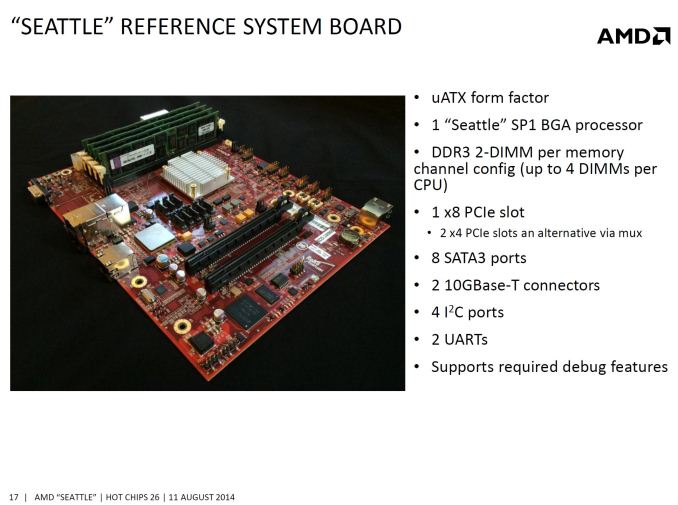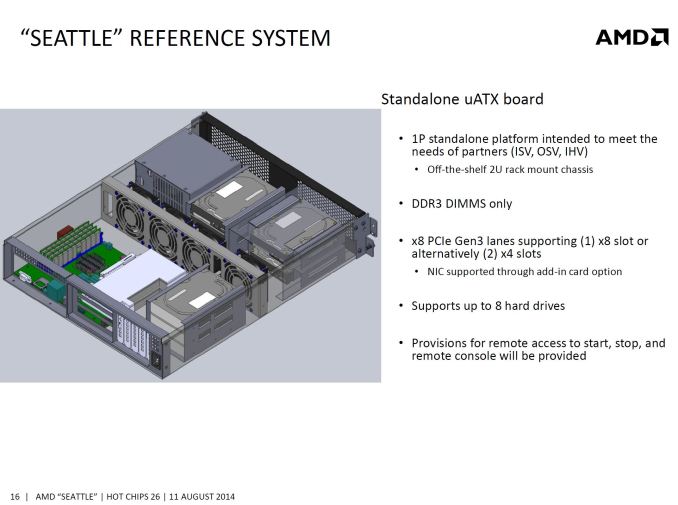AMD’s Big Bet on ARM Powered Servers: Opteron A1100 Revealed
by Stephen Barrett on August 11, 2014 12:00 PM EST- Posted in
- SoCs
- IT Computing
- AMD
- Arm
- Opteron
- server
- Enterprise CPUs
- Opteron A1100
Reference Design and Final Words
With the A1100, AMD is providing system integrators with a reference design µATX motherboard and 2U server rack. These will demonstrate SoC power delivery, IO and boot configuration, as well as SCP connectivity to integrators to utilize in their own designs.
Interestingly, despite the considerable horsepower contained inside the Opteron A1100 compared to previous non-AMD Cortex A9 server designs, AMD's reference server is clearly not specifically targeting web server applications. The reference design is not computationally dense as it only has one 8-core CPU node in a 2U chassis. The design is targeting storage servers with slots for 8 hard drives.
AMD’s presentation mentions a focus on datacenters where IO connectivity and low power consumption are more important than CPU horsepower. AMD certainly has plenty of server experience and will be well positioned to attack this market with this differentiated product. However, I could not shake the feeling AMD was missing an opportunity in micro severs by not targeting the web server application market with a more processor dense reference design. In fact, digging through our own content on the A1100, I found a quote from Anand saying “AMD sees huge demand in the memcached space, cold storage servers and Apache web front ends. The offer is pretty simple: take cost savings on the CPU front and pour it into more DRAM.” I agree with AMD, the A1100 is well suited for datacenter applications- but we only see one incarnation of that with the storage server reference design.
With the acquisition of SeaMicro adding fabric to AMDs long list of expertise, it is surprising to not see a micro server design that connects dozens of these processors together. Calxeda’s Boston Virdis server is exactly that, and our own conclusions stated that the design has huge promise if it was only a bit faster.
Perhaps it is due to excitement about this CPU that I am looking for a more innovative reference server design. All in all, that is not a bad position to be in. Perhaps it is enough to even convince micro sever companies to buy their CPU from AMD instead of designing their own. One thing is for sure, it will be interesting to watch the server market evolve over the next few years. It might not happen, but there could be a day when using your phone to post to Facebook is serviced end-to-end by ARM CPUs.













28 Comments
View All Comments
Gigaplex - Monday, August 11, 2014 - link
I'm not sure why you'd want Storage Spaces. The marketing sounds great, but there are many complaints all over the web that it just doesn't work as well as advertised. Parity mode in particular has unusably slow write speeds, and you can't expand the pool in an ad hoc fashion as was originally advertised - you have to add a collection of drives simultaneously which effectively just builds a second pool. And don't even ask about rebalancing. Conventional RAID5 is actually more flexible in practice.hechacker1 - Tuesday, August 12, 2014 - link
The latest Server2012 updates have largely fixed it. Yes, it's slow, but that's for data consistency. If you enable SSD tiering, I can max out my network connection. Or you can enable the ram write cache, if you have a UPS.The biggest problem is rebalancing, which it doesn't do. It also can't shrink a volume to safely remove a drive. But a lot of other RAID schemes don't support that either.
easp - Tuesday, August 12, 2014 - link
Keep in mind that Microsoft has quite a few servers of their own for Azure, Bing, etc. Thats the initial target market for this stuff, orgs that run their own software on big infrastructure.En1gma - Monday, August 11, 2014 - link
usb?davegraham - Monday, August 11, 2014 - link
Stephen, you also have to remember that AMD has separate divisions now (retail and embedded). the Embedded side absolutely could and will integrate into SeaMicro. ;) so, just remember, a dev kit isn't anything more than that....a dev kit. the final integration stages remain to be seen.Stephen Barrett - Monday, August 11, 2014 - link
I agree with you completely. I was just hoping they would make a big announcement on that simultaneously instead of the weak reference system shown.BMNify - Monday, August 11, 2014 - link
amd seem to have killed mass consumer/prosumer/SME uptake before they even start as these reference system designed 2U kit are being sold for 3000+ USD.selling your initial reference boards for to high a price massivly limits AMD's ability to mass produce these soc quickly at a good mass consumer price ($200 per chip for testing and product OEM development etc) so no initial mass uptake, and far longer time scales to get parity with other mass produced customer hardware, remember its an untested soc, and they need to prove its viability PDQ to make their ROI back and pay their bills etc...
iwod - Monday, August 11, 2014 - link
I must have missed it, why is it not targeting webserver application market?I find myself asking the same question whenever there is an ARM Server SoC article. What exactly does A1100 does better then Intel's Airmont based Server SoC? Yes, Airmont, the "14nm" version of Silvermont, compared to 28nm of A1100.
Wilco1 - Monday, August 11, 2014 - link
We can only compare it with Avoton for now as details for Airmont are not known yet. And it should be a good deal faster than Avoton (especially given it has 3x the amount of L2/L3 cache) and at better perf/W. Whether Airmont increases performance is unclear, power is likely reduced, but so 20 or 16nm versions of Seatle might be available next year as well, and those would significantly increase clockspeed.tuxRoller - Monday, August 11, 2014 - link
Wow. If this a video accelerator, this would be a tremendous soc for a media server/nas.All those sata ports, 10Gbe ports(!!!), ecc ram, and better performance/clock than silvermont when using the new isa.